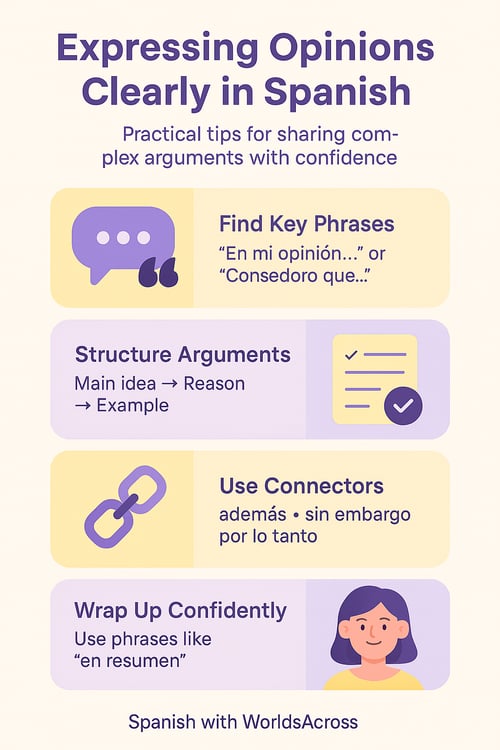How to Express Complex Opinions and Arguments in Spanish
Imagine having the ability to effortlessly express your opinions, discuss complex topics, and share your deepest thoughts in the language of Cervantes. Sounds amazing, doesn’t it? You’re not alone—most students learning Spanish aspire to communicate with confidence and authenticity, even when conversations become intricate. If this resonates with you, this article is for you. Today, I’ll show you how to structure your thoughts so you can present complex opinions and arguments in Spanish clearly, with practical examples and tips to make your journey easier.
Find Key Words and Phrases to Express Opinions
Expressing opinions in Spanish starts with knowing key phrases to kick off your thoughts. For subjective statements, phrases like “En mi opinión…” (In my opinion...) or “Considero que…” (I believe that...) are useful. These expressions soften your comments and indicate that what you’re saying is a personal perspective. Here are some examples to help you adapt them to your own opinions:
- “Desde mi punto de vista, aprender español es una gran herramienta de comunicación”
(From my point of view, learning Spanish is a great communication tool). - “Opino que el español es un idioma con mucha riqueza cultural”
(I believe that Spanish is a language with a lot of cultural richness).
Practicing these phrases aloud can help you gain confidence in your ability to express opinions in Spanish. Can you imagine sharing your ideas with Spanish speakers? With these phrases, you’ll feel more prepared to do so.
Build Clear and Structured Arguments
To delve deeper into a topic and defend your views, developing complex arguments in Spanish is essential. This doesn’t mean using difficult words or overly long sentences; clarity is key. A basic structure includes presenting your main idea, followed by an explanation or reason to support it, and finally, a brief example or conclusion.
Here’s how to structure your arguments:
- Main idea: “Aprender un segundo idioma mejora la memoria”
(Learning a second language improves memory). - Reason: “Estudios han demostrado que hablar más de un idioma aumenta la capacidad de recordar información”
(Studies have shown that speaking more than one language increases the ability to remember information). - Conclusion: “Por eso, aprender español no solo es útil, sino beneficioso para la mente”
(That’s why learning Spanish is not only useful, but beneficial for the mind).
Practicing this structure with various topics can improve your ability to present complex ideas. For example, if you’re discussing literature or cinema in Spanish, you can share your opinion about an author, director, or movie and back it up with details that make your arguments convincing.
Use Connectors to Smoothly Transition Your Ideas
For your ideas to flow and your arguments to be cohesive, connectors are essential. Common Spanish connectors include “además” (moreover), “sin embargo” (however), and “por lo tanto” (therefore). These create natural transitions between your ideas and keep the listener engaged. Here’s how to use them:
- “Me encanta el español; sin embargo, a veces es difícil entender los diferentes acentos”
(I love Spanish; however, sometimes it’s hard to understand the different accents). - “Aprender español es un reto; no obstante, el esfuerzo vale la pena”
(Learning Spanish is challenging; nevertheless, it’s worth the effort).
Expressing opinions in Spanish this way not only makes you sound more natural but also makes your arguments more fluid and convincing. Try incorporating these connectors into your conversations and you’ll notice the difference!
Practice Active Listening and Observe Native Speakers
Another way to improve expressing opinions and crafting complex arguments in Spanish is through observation. Listening to podcasts, watching movies, or even Spanish debates can provide insights into how native speakers build their arguments. Take notes on phrases or expressions that catch your attention and try to use them in your own interactions.
You’ll notice that native speakers often use expressions like “a mi parecer” (in my view), “pienso que” (I think that), or “me parece que” (it seems to me that) to introduce ideas. Beyond the words, gestures, tone, and rhythm also play a role in adding authenticity and confidence to your speech.
Conclude Your Opinions and Arguments with Confidence
To effectively wrap up your arguments, use phrases that reflect confidence in what you’re saying. Expressions like “en resumen” (in summary), “por lo tanto” (therefore), and “en conclusión” (in conclusion) help reinforce your message and provide a clear ending. Here’s a practical example:
- “En conclusión, el español es un idioma que ofrece muchas oportunidades culturales y profesionales. Aprenderlo es, sin duda, una inversión de tiempo valiosa”
(In conclusion, Spanish is a language that offers many cultural and professional opportunities. Learning it is undoubtedly a valuable investment of time).
By practicing these phrases at the end of your thoughts, you’ll convey confidence and leave a positive impression on your audience. Remember, your goal is to express opinions in Spanish and share your arguments authentically and clearly.

Ready to Share Your Point of View?
Expressing your thoughts clearly and directly in Spanish can be challenging, but with these tips, you’ll find it much easier to do. Don’t be afraid to experiment and use the expressions that make you feel comfortable. As with everything in language learning, consistent practice is the key.
At the end of the day, it’s not just about learning a language—it’s about connecting with people, cultures, and ideas, exchanging opinions, and reaching new horizons. We’re here to help you every step of the way. At WorldsAcross, we guide you to feel comfortable and confident expressing yourself in Spanish.
Go ahead—your ideas are waiting to be heard in another language!


